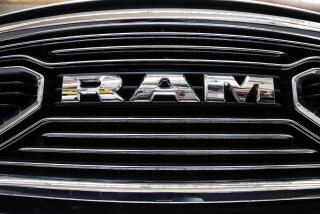Jury Deadlocks in Multibillion-Dollar Class-Action Suit Against Ford
- Share via
A state court judge in Oakland declared a mistrial Thursday in a multibillion-dollar class-action case against Ford Motor Co. after jurors deadlocked on whether the auto giant had concealed evidence of an alleged safety defect that caused its vehicles to stall.
It was an anticlimactic finish to the largest class-action case ever tried against a U.S. auto maker. A majority of jurors favored plaintiffs on both questions before them, but not by the 9-3 margin required for a verdict.
Plaintiffs’ attorneys had sought about $4 billion in compensatory and punitive damages on behalf of more than 3 million California residents who now or formerly owned Fords, Lincolns and Mercurys equipped with a component called the thick film ignition module, or TFI.
But the hung jury left Ford still exposed to a potentially huge judgment when Alameda County Superior Court Judge Michael Ballachey presides over a second phase of the marathon case beginning Dec. 1.
After 13 days of deliberations, jurors said they were deadlocked 7 to 5 and 8 to 4 on whether Ford had violated two provisions of the state Consumer Legal Remedies Act, which makes it illegal to misrepresent the quality of consumer goods.
“What a mistrial says is that at least some jurors recognize the difference between real engineering and courtroom engineering,” said Ford spokesman Jim Cain. “They recognize that our vehicles are safe and that we were honest with the government and . . . our customers.”
“So close and yet so far,” said Jeffrey Fazio, a lawyer for a consortium of six plaintiffs firms, after falling one vote short of victory. But Fazio said he was looking forward to the second phase before Ballachey and a retrial of the first phase after that.
Ballachey will rule on whether Ford violated another state statute, the Unfair Competition Law, by failing to inform vehicle owners and government agencies, including the National Highway Traffic Safety Administration, of the risk of vehicles stalling due to TFI failures. The statute provides for a judge, rather than a jury, to consider requests for relief, resulting in a splitting of the case.
Plaintiffs lawyers will ask Ballachey to order Ford to recall and repair an estimated 1.8 million TFI-equipped vehicles in California that are still on the road. They are also seeking an order forcing Ford to disgorge an estimated $900 million in profits allegedly earned by the company through its misconduct.
Beyond that, similar class-action suits against Ford are pending in Tennessee, Illinois, Maryland, Washington and Alabama on behalf of millions more owners of TFI-equipped Ford vehicles, of which an estimated 16 million nationwide remain in use.
Clarence Ditlow, director of the Center for Auto Safety, a nonprofit advocacy group co-founded by Ralph Nader, said Thursday the only real question is where Ford will suffer its first big loss. “It’s important to establish the principle that if you mislead the government to avoid a recall, you can still be held accountable by the . . . judicial system,” Ditlow said.
Ford argues that it did not mislead consumers or the government, and that rates of stalling of Ford vehicles are comparable to those of other manufacturers. Cain, the Ford spokesman, said plaintiffs’ attorneys, in their quest for fat fees, had gone to “extreme lengths” to find vehicle owners to say they had been wronged.
The TFI module is a device that regulates the flow of electrical current to spark plugs. From 1983 until 1995, Ford installed the device in about 22 million Ford, Lincoln and Mercury vehicles. While other manufacturers also utilized the TFI, plaintiffs say Ford’s decision to mount it on the distributor exposed it to excessive heat, allegedly causing a high rate of failures that triggered stalls not only during vehicle start-ups but at highway speeds.
In 1987, Ford conducted a limited recall of 1.1 million four-cylinder cars for which the TFI warranty replacement rates were running well above 40%. But it persuaded NHTSA that recalls were not required for other make and model years. Evidence produced in court showed that TFI warranty replacements for other Ford vehicles ranged from less than 1% to more than 16%.
Appearing as a star witness for the plaintiffs, former NHTSA enforcement chief Michael Brownlee testified that during agency probes of stalling complaints in the 1980s, Ford had failed to reveal all it knew about the TFI problem.
Reviewing internal Ford records obtained by plaintiffs attorneys, Brownlee identified 17 documents that he said the company should have provided but didn’t in response to NHTSA queries. In its own review of the documents, the agency concluded that Ford should have provided five of the documents, but took no further action.






